Development of the Pi Nora for Conservation According to Theories of the Creative Economy
Keywords:
Conservation, creative economy, development, inheritance, pi noraAbstract
The pi nora is a wind instrument used to accompany traditional nora performances in Southern Thailand. Despite some similarities to other musical forms in Southeast Asia, this particular genre of music is different from the music in other regions of the world and the instruments reflect the local environment and the lifestyle and culture of the Southern Thai people. However, there is very little inheritance of pi nora playing methods from the older generations to the new, which is putting the continued development of the instrument at risk. The creative economy is one way to add value to the instrument and generate new economic and social benefits of inheritance. Therefore, this qualitative investigation was set up to conserve and develop pi nora. The three research objectives were 1) to explore the identity and traditional knowledge concerning the pi nora, 2) to study the current conditions and problems with inheritance and development of the pi nora and 3) to create a conservation and development model for the inheritance of the pi nora according to the principles of creative economy. Data was collected from 63 purposively selected individuals. Results show that
1) the pi nora is an instrument whose origin is closely related to spiritual beliefs, Brahmanism and Buddhist faith. The instrument helps build relationships between people in society and between humans and religion; Nevertheless, 2) there is an inheritance crisis that must be addressed; 3) in terms of the method for development of the pi nora according to the principles of the creative economy, the researchers synthesised development methods of new products and determined 5 suitable steps.
References
Benedict, R. (1934). Patterns of culture. Boston, MA: Houghton Mifflin.
Jantavanit, S. (2003). Data collection method in qualitative research. Bangkok: Chulalongkorn University Press. [in Thai]
Kaewbangan, W. (2009). Method of conservation and development of bamboo machinery in Nakhon Ratchasima Province. Mahasarakham: Mahasarakham University Press. [in Thai]
Howkins, J. (2002). The creative economy: How people make money from ideas. London: Penguin.
Kasempholkoon, A. (2011). Creative Ramayana for the value adding of Thai products and tourism: A study of creative folklore. Lokaratna, 4(1), pp.1-12. [in Thai]
Makhunton, S., Chantachon, S., and Phothibat, P. (2014). Integration of the local wisdom of natural-dyed mud-treated silk in Thailand for creative economy. In Advanced Materials Research, 860(1),pp. 2695-2699. [in Thai]
McCloud, D. G. (2018). Southeast Asia: Tradition and modernity in the contemporary world. London: Routledge.
Naksen, S. (1996). Nora: Ramkhianprai-Yieblookmanao. Bangkok: Chulalongkorn University Press. [in Thai]
Newbigin, J., Rosselló, P., & Wright, S. (2010). The creative economy: An introductory guide. London: British Council.
Nootong, U. (1993). Nora. Srinakharinwirot University: Srinakharinwirot University Press. [in Thai]
Office of the National Economic and Social Development Board. (2003). Ninth national economic and social development plan. Bangkok: Office of the National Economic and Social Development Board. [in Thai]
Pangkesorn, A. (2013). Thai arts & creativity: The new identity for Thai Foods Catering. Veridian e-Journal International Humanities, Social Sciences and Arts, 6(6), pp. 31-55.
Pongpaiboon, S. (1997). Traditional knowledge of the Southern Thai people [in Thai]. Southern Thai Studies 4(3), pp. 21-41.
Pornhomali, K. (2009). Strategies for playing pi nora of Kru Amnat Nuniat [in Thai]. Bangkok: Chulalongkorn University Press.
Prempree, A., Chantachon, S., & Wannajun, S. (2014). The integration of traditional knowledge in the design and development of mudmee, praewa and yok tong silk products for enhancing community economy. Indian Journal of Traditional Knowledge 13(2), pp. 305-12
Santisombat, Y. (2004). Ecotourism: Diverse cultures and natural resource management. Chiang Mai: Withindeeshine. [in Thai]
Srisantisuk, S. (2001). A study of society and culture: Concepts, philosophies and theories. Khon Kaen: Khon Kaen University. [in Thai]
Steward, J. (1955). Theory of culture change: The methodology of multilinear evolution. Urbana, IL: University of Illinois Press.
Tuamsuk, K., Phabu, T. & Vongprasert, C. (2013) Knowledge management model of community business: Thai OTOP champions, Journal of Knowledge Management, 17(3), pp.363-378. [in Thai]
Wanichakorn, A. (2013). The development of pottery souvenir product to value creation at Koh Kret, Nonthaburi. Fine Arts Journal, 17(2), pp.134-143. [in Thai]
Wattanacharoensil, W., & Schuckert, M. (2016). Reviewing Thailand's master plans and policies: Implications for creative tourism?. Current Issues in Tourism, 19(10), pp.1045-1070. [in Thai]
Downloads
Published
How to Cite
Issue
Section
License
The authors retain the copyright to their article but the Journal of Liberal Arts, Prince of Songkla University reserves the exclusive rights to first publication.






